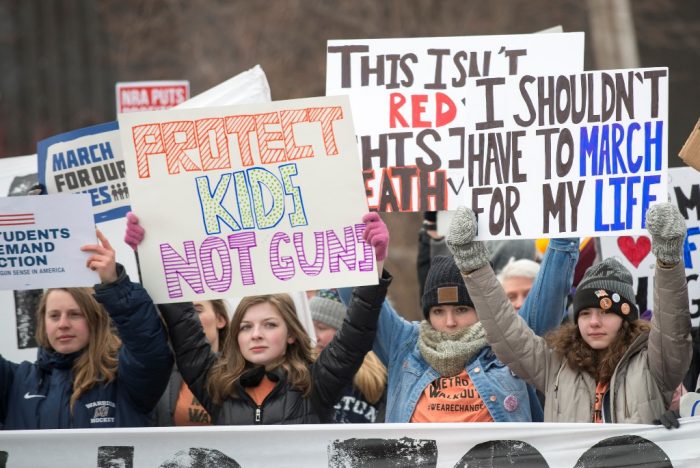“Instagram threat posted yesterday. We are dedicated to keeping the students calm.”
Every neighborhood is a tough neighborhood now.
Children go to school each day vaguely aware that a deadly incident could occur.
One morning, I checked my email at 11:00 a.m. and there was a 30-minute-old message from our high school principal telling parents not to be alarmed. He wanted us to know that there was a credible threat—the police had only just informed him. They were handling it before it got to the school.
My heart was already on the carpet. The email concluded with a hope that the school’s goal of maintaining order and calm among the students would be shared by the parents.
For me, this was a “pick my daughter up from school now” situation.
We adults feel helpless and search for some level of civic engagement to undo this reality.
My four younger children have monthly lockdown drills at their elementary school. It is a surreal game the children innocently play because they know that really, grown-ups have their back. The littlest ones are told they are preparing for a big dog running down the hallways.
The larger social problem will not be eliminated during the time these children are in school.
Gun laws restricting access can help.
Security in buildings is good.
Adequate research on psychotropic drug treatment for children is necessary—one of the causes of school violence is said to be overmedicated students, which is often used to minimize the need for gun control. So, first, research can help advance proper dosing for children with mental health issues. Second, addressing the issue of drug treatment allows the gun control debate to be unharnessed from the mental health aspect.
But it’s always been a tall order to protect a society from a lone gunman.
First, we should find out what legislation is up for votes in our state. Learn which candidate supports your view.
In the meantime, we have the children of this moment, whose hearts should get as much ease and confidence as possible.
Here is a holistic approach.
1. Provide learning and enrichment in other ways, so that learning is not only associated with a school environment.
Trained as a preschool through middle school teacher, I see that the wellspring of hope within cognitive learning is always interpersonal. That interpersonal relationship can be between an author and a reader, or any two people exploring a topic of interest. These moments of being “in the zone” together are like a deep meditation, and are more accessible to children than actual meditation. Stories and art expression are also ways to release that wellspring of trust in one’s own basic dignity.
2. At least once a month, go out into nature with your kids, regardless of their age, from toddlers to teenagers.
Spending time in nature releases endorphins and encourages humans to live from a deeper place in themselves. There are a bunch of scientifically supported reasons including an increase in Vitamin D, unplugging from technology, and better sleep regulation. Studies at the National Academy of the Sciences have observed this.
3. Become more of an expert in mental health than you ever planned to be.
The science of neurology and specifically, the parasympathetic system, gives us tools to know joy while acknowledging pain. We can engage in meditation, yoga, prayer, and psychological counseling to achieve this.
I spoke with a family therapist and a yoga professional, both experts in healing, and asked what they recommend to build resiliency and also to heal after traumatic events.
Q. Is there any way to provide resilience? What are the best ways to address anxiety after trauma?
Vicki Hoskins, LMFT, writes that:
“The best way to build resilience in children is to be age-appropriately honest with them, to be available to talk, answer their questions, and come up with your own observations to use reflectively in communicating with children. They also need a lot of reassurance and to know that their parents are there for them. In the worst situations, we can imagine children who survive relatively well have community—family, friends, etc.
The worst thing parents can do is deny their children’s reality and try to brush their concerns aside, believing somehow that denial will keep them safe.
The same with anxiety, really. It’s fear of the unknown, the unknown future and not knowing what to expect. And of course, despite our best efforts we can’t protect our children from everything.”
Jenn Nelson, a yoga educator, speaks about the way that our adrenal glands can be habituated to more or less reactivity. She writes:
“A balanced system needs to be in place. [For example] a yoga practice, a routine around nourishment both physically and mentally. So, in simple terms, having consistent physical exercise, good sleep hygiene—sleeping during the time when the body naturally detoxifies (10 to 2 a.m.)—and eating foods that speak to your constitution will cultivate resiliency. Building a new pattern of behavior on top of an old pattern is how we leave things behind, like a traumatic event or chronic stress. If drama is held in the tissue, it will always be there to collect and hold onto stress. If it is released from the tissue, there is more space for new patterns or habits to form.”
A respected meditation teacher, Tara Brach, was asked by a high school teacher at a conference at Omega Institute this summer how to introduce mindfulness to kids.
The young teacher said her students are so overstimulated that silence “freaks them out, and their ability to form real connections with people is so diminished.” Tara agreed, saying that “the hope for our world is that the practices and the teachings of coming into your heart is there for this next generation.”
She pointed to a prototype teacher-training organization, Minds, which has brought mindfulness to more than 10,000 children in the urban area of Washington, D.C.
There is also a clinical approach to PTSD (post-traumatic stress disorder) that pulls together different strands of treatment. CRM (comprehensive resource model) builds resilience through personal connection and by layering inner resourcing. School administrators who support best practices can be helpful by allowing social workers and guidance counselors to be trained in this approach.
I’m glad the adults around my kids have tools which are driven by neuro-biological research. At home though, I’m the one who has to slow down and be ready for worrying conversations with the second-grader or the 16-year-old. It feels awkward to me to reassure them of my support, but I’m going to trust the experts and just do it.
I can model and share personal practices like yoga or gardening that build new neural pathways. This not only builds relationships, but allows space for healing in the emotional body (a yoga term for the parasympathetic system).
I appreciate the advice to avoid turning away from their painful questions. I may have to start thinking of age-appropriate answers now.
When we step forward to pay attention to gun control and mental health solutions, a fierce noble energy exists, and moves us to build graceful resilience for our family and community.
With modern insight, the appalling battle zone of our children’s landscape can be seen realistically, and their hearts grow big enough to live well despite it.
I am grateful that both our high school and the elementary are proactive. The Instagram threat, as it turns out, was aimed at another school and was neutralized. My daughter was stoked to get a half-day off school.
And thanks to the collective wisdom of different disciplines, I can be a better parent in uncertain times.
~









Read 0 comments and reply